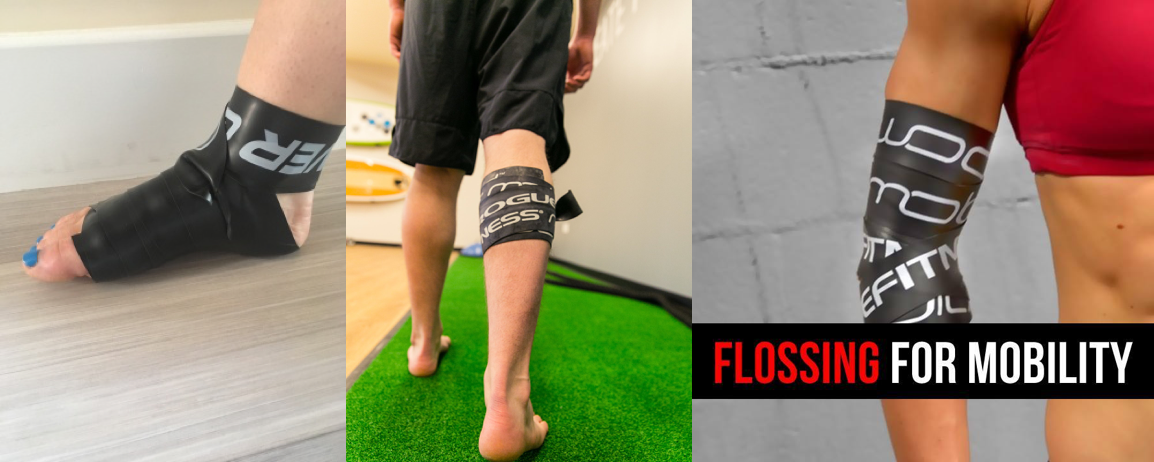Laurie's Blogs.
Mar 2019
Joint or Tissue Flossing - Could we use this on dogs?

If you’ve been following the Four Leg Facebook page, you’ll see where there have been posted about Blood Flow Restriction training. A topic I’ve blogged about in the past.
https://www.fourleg.com/Blog/350/Blood-Flow-Restriction-Training...-Ever-heard-of-it??
An Aussie Vet ask the question, is this the same as joint flossing. So, I had to look that up. The answer is ‘sort of’!
Here’s the gist… (and I’m really toying with the idea of trying it out). With joint (or tissue) flossing, you wrap a rubbery-elastic strap / band around a joint or muscle group. Okay, it’s latex. The band is thicker than theraband, and you wrap it with about a 50% pull, so that it’s on there snug and tight. Then you do some exercises with the wrap on. From what I can tell in reading articles and blogs, and the handful of published articles I found on PubMed, you would leave it on for about 5-minutes. Five minutes is what I found in the research articles… I’m searching for times in the ‘public’ promo stuff (blogs, articles, manufacturer suggestions).
Why might it work?
Well, the research isn’t yet caught up with the more clinical research of what it helps. So the ‘why’ is a bit of an educated guess.
1 Mechanical effects: The restrictive properties of the band during ROM can contribute to alterations in fascial gliding, displacement of edema, and help with joint positioning.
2. Neurological effects: Any touch has a neurological response. As such, these bands may have an impact of proprioception, motor control, or pain management.
3. Chemical effects: Here we look to the research (and thoughts) on blood flow restriction (BFR) training. BFR stimulates muscle protein synthesis, depletion of phosphocreatine stores and decreases in muscle pH, and decrease in the mRNA gene expression of MURF-1, atrogin, and myostatin. The hormone and blood flow rush following release of the tension, has been shown to improve recovery, create strength gains with minimal loads, increase hypertrophy, as well as induce a higher recruitment of fast twitch fibers due to the reduced availability of oxygen while under the restriction of the band.
How?
Well, it looks to be as simple as wrapping the band around a limb or joint. Commenters on blog posts suggest wrapping from top to bottom in case the band rolls down and you lose your edge in order to most efficiently get it off.
Don’t wrap your head, chest or neck.
Contraindications would be high blood pressure, deep vein thrombosis, pregnancy, varicose veins, and cardiac disease. (To be honest, I think there could be more, but this is what I’m seeing pop up on most of the blogs and articles I’ve looked at.)
What are the benefits?
The research articles out there claim benefits for ROM, jump and sprint performance (when wrapping an ankle). Whacky stuff… it helps for up to 45 minutes after application! And it seems that the benefits are more statistically significant for recreational athletes than for professional athletes.
What do I think?
Well, I’ve put in my order for a wrap and for BFR cuffs on Amazon. I want to see what I think of this for myself. Does it ache? Could I get a dog to ‘buy into it’? Do the wraps or bands pull on hair? (I’ll test on hubby first and then the Borzoi – she’s a princess, so she’ll let me know), and if all goes well, then I’ll select a patient or two to test on!
I said this the last time… but I sense a training video coming on!
If you’ve used either of these techniques yourself and have any feedback to give, please please give me a shout! Thanks gang!
Cheers! Laurie
References:
https://www.frontiersin.org/articles/10.3389/fphys.2012.00392/full
https://www.massagemag.com/science-floss-bands-mobility-88142/
https://www.ncbi.nlm.nih.gov/pubmed/28950149
https://www.ncbi.nlm.nih.gov/pubmed/28254581
https://www.ncbi.nlm.nih.gov/pubmed/30676229


